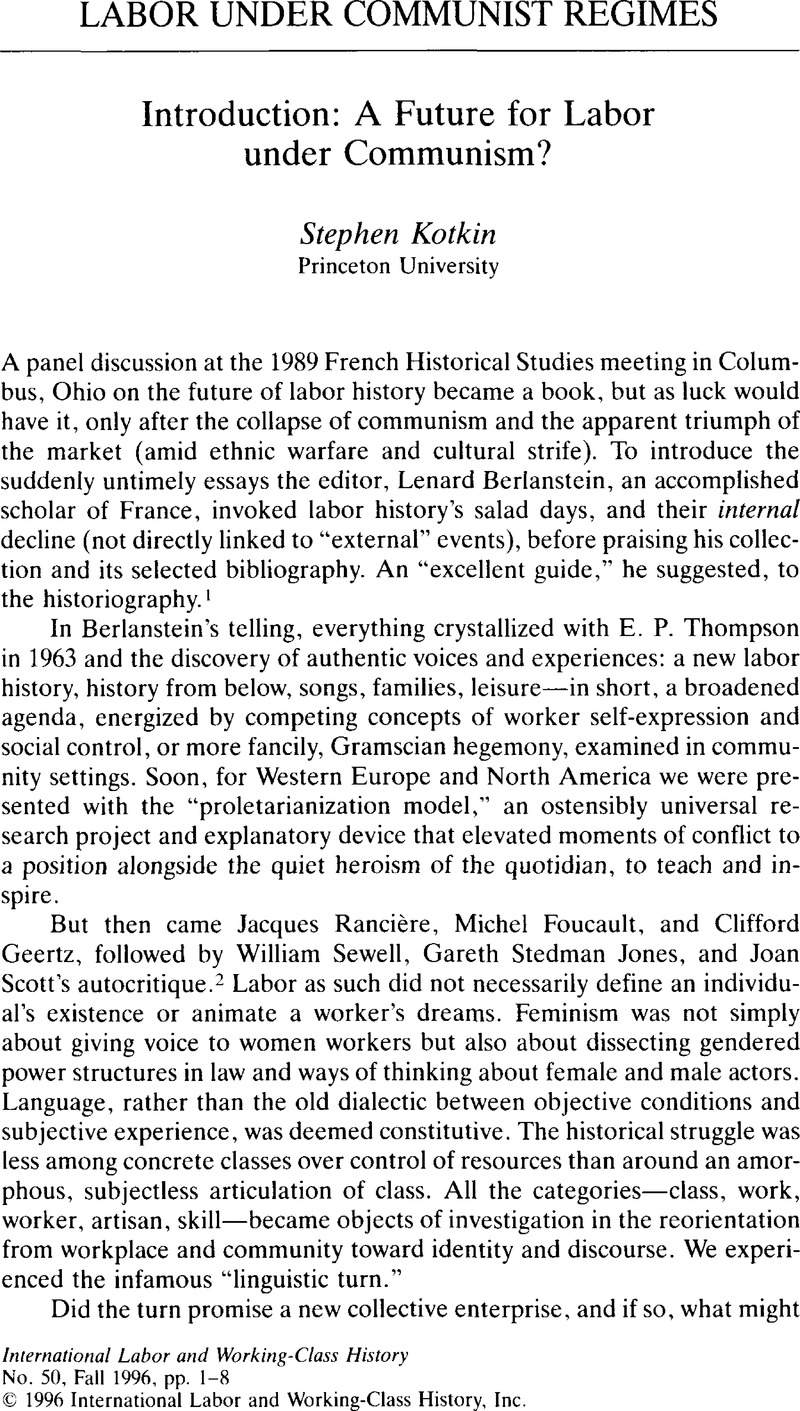Article contents
Introduction: A Future for Labor under Communism?
Published online by Cambridge University Press: 16 December 2008
Abstract

- Type
- Labor Under Communist Regimes
- Information
- Copyright
- Copyright © International Labor and Working-Class History, Inc. 1996
References
NOTES
Thanks to Cynthia Hooper, Philip Nord, and Andy Rabinbach for their comments.
1. Berlanstein, Lenard R., “Introduction,” in Rethinking Labor History: Essays on Discourse and Class Analysis, ed. Berlanstein, Lenard R. (Urbana, 1993). 1–14.Google Scholar
2. See the exchange in International Labor and Working-Class History 31 (Spring 1987): 1–36.CrossRefGoogle Scholar
3. Schwarz, Solomon, Labor in the Soviet Union (New York, 1951).Google Scholar
4. Laba, Roman, The Roots of Solidarity; A Political Sociology of Poland's Working-Class Democratization (Princeton, 1991).Google Scholar
5. For a guide to the various protagonists and their sometimes conflicting views, see the essays in Siegelbaum, Lewis H. and Suny, Ronald Grigor, eds., Making Workers Soviet: Power, Class, and Identity (Ithaca, 1994).Google Scholar
6. One dissenter is Donald Filtzer, who, like Schwarz, characterized Soviet regime-worker relations as inherently antagonistic (thereby also obviating the need to investigate actual worker or regime attitudes). Filtzer modified Schwarz, however, showing that because of the absence of unemployment, workers under communism exercised considerable control over the production space. He could thus explain the seeming paradox of a state willing and able to use massive repression yet unable to get its way on the shop floor and raise productivity. Filtzer, , Soviet Workers and Stalinist Industrialization: The Formation of Modern Soviet Production Relations, 1928–1941 (Armonk, 1986).Google Scholar
7. Much of Western Marxism gave up altogether on productionism and concrete workers' struggles without, however, abandoning a sense of totality or universal interests. Some Western Marxists retained the concepts of class consciousness and even of the proletariat while refusing to interest themselves in living workers or labor. See the review essay by Rabinbach, Anson, “Science, Work, and Worktime,” International Labor and Working-Class History 43 (Spring 1993):48–64.CrossRefGoogle Scholar
8. In this regard the extensive and highly sophisticated literature on prerevolutionary Russian labor stands out for its engagement, even exhilaration, as well as for its reflection of dreams and aspirations for the United States and Great Britain that went unfulfilled. For space reasons I omit consideration of these voluminous writings, a topic given extensive coverage in previous issues of ILWCH. My views can be found in Kotkin, Stephen, “OneHand Clapping: Russian Workers and 1917,” Labor History 32 (1991):604–20.CrossRefGoogle Scholar
9. For a luminous elaboration and demonstration of how imaginings are rooted in material culture and in turn make material conditions “real,” see Biernacki, Richard, The Fabrication of Labor: Germany and Britain, 1640–1914 (Berkeley, 1995).Google Scholar
- 1
- Cited by


